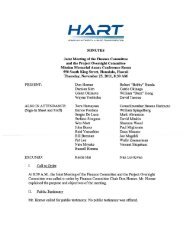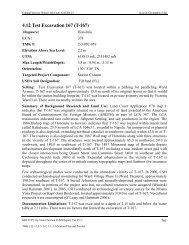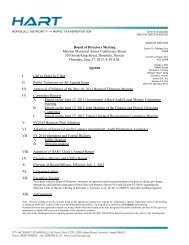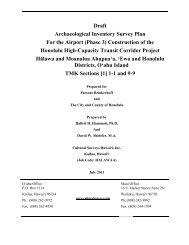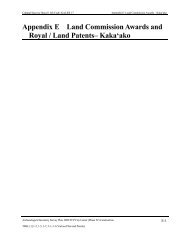AISP Kamehameha Highway Guideway - Honolulu Rail Transit Project
AISP Kamehameha Highway Guideway - Honolulu Rail Transit Project
AISP Kamehameha Highway Guideway - Honolulu Rail Transit Project
Create successful ePaper yourself
Turn your PDF publications into a flip-book with our unique Google optimized e-Paper software.
Cultural Surveys Hawai‘i Job Code: MANANA 1<br />
Background Research<br />
2.1.2.6 ‘Aiea<br />
In ancient times, Keaiwa Heiau was the site of a medicinal herb garden and training area for<br />
traditional healers:<br />
At the time the Keaiwa heiau at the top of Aiea Heights was discovered in 1951 to<br />
be the ruins of an ancient medical center, few Hawaiians knew of its ancient<br />
usage.<br />
Eminent anthropologists acknowledged that they had never heard of such centers<br />
but were convinced when several Hawaiians independently told of them.<br />
In telling of these centers, Mrs. Mary Kawena Pukui, associate in Hawaiian<br />
culture at the Bishop Museum, translated the name Ke-a-iwa as<br />
“Incomprehensible.”<br />
The thought being that no one could explain the powers of the priests or the herbs<br />
used in healing.<br />
She said Ke-a-iwa came from an obsolete word aiwa-iwa which means the<br />
mysterious or the incomprehensible.<br />
Further confirmation of the use of Ke-a-iwa has lately been given me by Paul<br />
Keliikoa, a Hawaiian living in Aiea.<br />
Mr. Keliikoa has the story from his grandmother Kamoekai.<br />
In her day Ke-a-iwa was interpreted as “a period of fasting and meditation” and<br />
the heiau was so named because novitiates in the art of healing spent long hours<br />
in fasting, praying and meditation.<br />
Kamoekai also told her grandson that the very young were taken to Ke-a-iwa to<br />
be trained as kahuna lapaau. There they were taught the prayers needed to<br />
compound medicines and heal the sick.<br />
They cared for the great herb garden which lay beyond the heiau walls.<br />
After the novice learned his first steps in the art of the kahuna lapaau, he was sent<br />
out to other medical centers to learn the advanced art of diagnosis and other<br />
treatments.<br />
Mr. Keliikoa’s interpretation of the name means a change in the pronunciation.<br />
Not Ke-a-iwa, but Ke-ai-wa.<br />
Ke-ai is the Hawaiian word for fasting. [Saturday Star Bulletin Feb. 28, 1959,<br />
cited in Sterling and Summers 1978:11-12]<br />
2.1.2.7 Hālawa<br />
Leilono and the Wandering Spirits<br />
Leilono, located on Red Hill in Hālawa, was said to be a place where wandering spirits would<br />
enter the “eternal night”:<br />
Archaeological Inventory Survey Plan, HHCTCP Construction Phase II, Waiawa, Mānana, Waimano, Waiau,<br />
Waimalu, Kalauao, ‘Aiea, and Hālawa Ahupua‘a, ‘Ewa District, Island of O‘ahu<br />
TMK[1] 9-7, 9-8, and 9-9 - Various Plats and Parcels<br />
34



